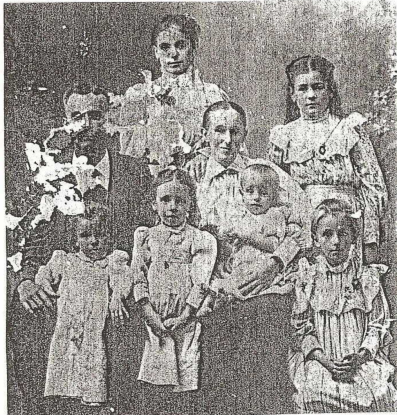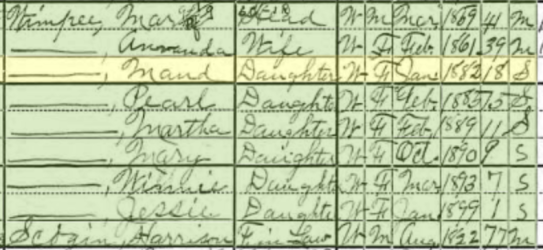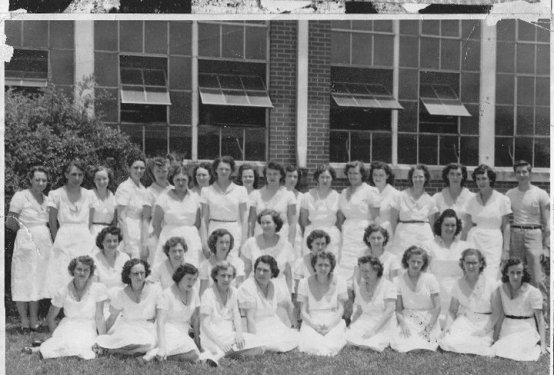Being the oldest sibling comes with a lot of responsibility. Parents rely on you, and your younger siblings look up to you. I’m the oldest sibling myself, and I can only imagine what it would be like to be the oldest of 11 siblings! My 2nd great grandmother, Maude Melissa Wimpee, was in just that position.

Maude was born on 17 January 1882 in Chattooga County, Georgia to Mark Washington Wimpee and Amanda Alice Scoggins. Mark was a farmer and blacksmith, and Amanda was the daughter of a Civil War veteran. They married on 13 March 1881, and their oldest child, Maude, was born almost 10 months to the day later.
Unfortunately, I do not know the names of all of Maude’s 11 siblings. The siblings whose names I do know include: Pearl (b. 1885), Martha (b. 1889), Mary (b. 1890), Winnie (b. 1893), Walter (b. 1895), Jessie Irene (b. 1899), and Ernest William (b. 1902). Martha, Winnie, and Walter all died as children, and the other three unnamed children must have died young as well, between Mark and Amanda’s marriage and 1900.

By 1900, Maude, her parents, her 5 living siblings – Pearl, Martha, Mary, Winnie, and Jessie – and her grandfather Harrison Scoggins were living in Trion, Georgia.

The biggest employer in Trion was the Trion Factory, a cotton mill, which opened in 1845. It had the distinction of being the first cotton mill in northern Georgia. Trion existed because of the mill; the company built and owned most of the houses and established the school. The Wimpee family, like most of their neighbors, worked for the mill and rented a house in town from the company. Mark worked as a blacksmith at the mill, and his three oldest daughters followed him there. Maude was 18 years old at the time, working as a weaver. Her younger sisters Pearl, aged 15, and Martha, aged 11, worked as spinners. In the past year, Maude worked 10 months with mechanized looms, a difficult and dangerous job. She likely worked six days a week, upwards 12 hours a day for a weekly pay of around $5. More men than women worked as weavers, so it was a little more unusual for Maude to hold that position. Maude had probably worked at the mill for a long time, as children under the age of 10 often worked to help out their parents. Spinning was an entry level job, one that was perfect for children under 16 like Pearl and Martha. There were also health risks for cotton mill workers, besides losing fingers in the machinery. Mill workers breathed in air filled with cotton particles, which would lodge in their lungs and cause byssinosis, or brown lung. Symptoms included coughing, wheezing, and sometimes death if the respiratory system failed.

By 1910, Maude and her older siblings were married and all escaped the cotton mill. Her father, Mark, was still working at the mill as a blacksmith, but her sister Jessie, though 11 years old, was not recorded as working, unlike Martha 10 years earlier. Either Mark was more financially stable with only four people living at home or Jessie’s employment was not recorded accurately.
On 11 November 1901, Maude married John Luther Kimbell also of Chattooga County. They ultimately had a large family of 9 children: Lula, Maggie, Jennie, Nellie, William, Pearl, Jimmie, Martha, Clara, and Ernest. John was a blacksmith like Maude’s father, though in their early married life they farmed rented land in Lyerly, Georgia. However, by 1920, Maude and John were living in Trion and Maude found herself living in rented, company housing just like where she, her parents, and siblings lived when she was a girl. John worked as a blacksmith for Mount Vernon Mill, and his oldest daughter, 17 year old Lula May, worked as an inspector in the cloth room.
By 1930, Maude and John owned their home in Chattooga County, but they were still very involved in the cotton mill. John was working as a welder for the mill, 18 year old son Bill was working in the south room doing an unspecified job, and 16 year old Berel was working as a spinner. 10 years later, John was no longer working for the mill. Maude and John’s 32 year old single daughter, Jennie Lee, was working as an inspector at the mill, and their married daughter Pearl was employed at the Trion Glove Mill as a sewer.

Like most families living in a mill town, it seems that Maude’s life revolved around the mill. Three generations of her family worked there, and I found it very interesting that the sibling who worked in the cotton mills as children had a higher chance of marrying men who worked in the mills and finding employment for their children in the mills as well. The younger siblings who didn’t work in the mills as children didn’t work in them as adults, didn’t marry people who worked in them, and their children found other employment. For example:
Pearl Wimpee Jackson Crisp – Pearl and her second husband, Felix, lived on a farm in 1920, but by 1930, they were living in Trion again. They rented a house for $5.00 in a mill company neighborhood. Felix worked at the cotton mill as a napper, and their 20 year old son Clinton worked there as a weaver. In 1940, Pearl and her family had moved to Walker County, Georgia, where Felix now worked on a farm, but their oldest son Clinton still worked in a cotton mill as a doffer.
Martha Wimpee – She worked in the mills as a child and died sometime between the 1900 and 1910 census. I wonder if she died from complications from working at the cotton mills.
Mary Wimpee Philips – She married Albert Philips, a farmer. She didn’t work in the mill as a child, unless it went unrecorded, and she, her husband, and children did not work in the mills.
Winnie Wimpee – The census did not record that she ever worked in the cotton mill, but she, like Martha, also died sometime between the 1900 and 1910 census.
Jessie Wimpee Kearsey – She married Claude Kearsey, and they moved around during their marriage. Claude worked in different capacities over the years, but according to the census records, not in the cotton mills.
Ernest William Wimpee – He worked contracting jobs during his adult life, and as far as I can tell, never worked in the mills unless it went unrecorded in the census.
Of the 5 Wimpee children who lived to adulthood – Maude, Pearl, Mary, Jessie, and Ernest – Maude died first. She lived to be 80 years old and was well loved by her family. I can only imagine that being the oldest sibling in such a large family and working in a cotton mill as a child and young woman must have had quite an impact on her and her actions throughout her life.